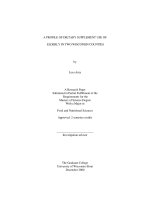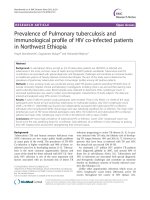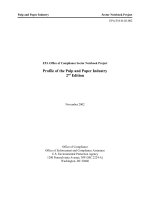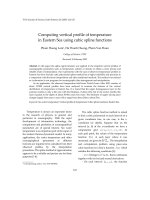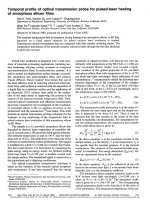Nutritive profile of ivory shell babylonia zey
Bạn đang xem bản rút gọn của tài liệu. Xem và tải ngay bản đầy đủ của tài liệu tại đây (452.41 KB, 9 trang )
See discussions, stats, and author profiles for this publication at: />
Nutritive Profile of Ivory Shell Babylonia zeylanica (Bruguiere, 1789)
(Mollusca: Gastropoda: Babyloniidae)
Article in National Academy Science Letters · June 2013
DOI: 10.1007/s40009-013-0137-z
CITATION
READS
1
52
3 authors, including:
Murugan Arumugam
Venkatesan Vellathi
Vivekananda College of Arts and Science, Agastheeswaram, Kanyakumari, Tamil …
Central Marine Fisheries Research Institute
34 PUBLICATIONS 163 CITATIONS
32 PUBLICATIONS 93 CITATIONS
SEE PROFILE
Some of the authors of this publication are also working on these related projects:
Oceanic cephalopods in Arabian Sea View project
Development of fisheries management plans for bivalve fisheries View project
All content following this page was uploaded by Murugan Arumugam on 12 April 2018.
The user has requested enhancement of the downloaded file.
SEE PROFILE
Nutritive Profile of Ivory Shell Babylonia
zeylanica (Bruguiere, 1789) (Mollusca:
Gastropoda: Babyloniidae)
Kaila Kesavan, Arumugam Murugan &
Vellathi Venkatesan
National Academy Science Letters
ISSN 0250-541X
Natl. Acad. Sci. Lett.
DOI 10.1007/s40009-013-0137-z
1 23
Your article is protected by copyright and all
rights are held exclusively by The National
Academy of Sciences, India. This e-offprint
is for personal use only and shall not be selfarchived in electronic repositories. If you wish
to self-archive your article, please use the
accepted manuscript version for posting on
your own website. You may further deposit
the accepted manuscript version in any
repository, provided it is only made publicly
available 12 months after official publication
or later and provided acknowledgement is
given to the original source of publication
and a link is inserted to the published article
on Springer's website. The link must be
accompanied by the following text: "The final
publication is available at link.springer.com”.
1 23
Author's personal copy
Natl. Acad. Sci. Lett.
DOI 10.1007/s40009-013-0137-z
RESEARCH ARTICLE
Nutritive Profile of Ivory Shell Babylonia zeylanica (Bruguiere,
1789) (Mollusca: Gastropoda: Babyloniidae)
Kaila Kesavan • Arumugam Murugan
Vellathi Venkatesan
•
Received: 17 September 2012 / Revised: 14 February 2013 / Accepted: 1 April 2013
Ó The National Academy of Sciences, India 2013
Abstract Molluscs are delicious and protein rich food
among the sea foods. The gastropods in the coastline could
form an important source of food, raw material for village
industries, indigenous medicine, etc., and it is widely used
as a cheaper food source for coastal area people. Due to the
importance and abundance of the commercial gastropod
species, Babylonia zeylanica that commonly occur in
intertidal areas of Indian coasts; this study investigates the
nutritive value of B. zeylanica. Identification and quantification of B. zeylanica were done by using standard methodology. The results of the present study provides not only
the information about the composition but also recommended the consumption of this whelk B. zeylanica since
they are rich in minerals, vitamins,. It could also be added
that the consumption of marine gastropod is a nutritional
assurance to millions of malnourished hungry people. The
malnutrition problem in our country can be overcome by
effective utilization of nutrient rich molluscan seafood.
Overall, B. zeylanica was similar or superior to other
marine shellfish and hence B. zeylanica could be utilized as
an alternative meat source in human diet.
Introduction
Humans and shellfish have been inextricably linked for
millennia, not only as an important animal protein source,
providing many millions of livelihood means and food
security at large, but also from an evolutionary viewpoint.
Fatty acids are the fundamental structural components of
practically all forms of lipids. From the point of view of
human health, it is thus important to increase the consumption of fish and other marine organisms which are rich
in polyunsaturated fatty acids of the n-3 family and poor in
polyunsaturated fatty acids of n-6 family [1]. Vitamins are
organic compounds representing a minor fraction in the
day today life. Based on solubility, vitamins are differentiated as fat soluble A, D, E and K and water soluble B and
C. Mollusc is a good dietary source of vitamin B complex.
Minerals are required for the normal life processes of all
animals including Molluscs. The edible and commercially
important species B. zeylanica is abundantly distributed in
the southeast coast of India [2, 3]. The common species of
Babylon snail (Babylonia areolata) are marketed alive in
the fish markets of Philippines and Thailand [4].
Keywords Fatty acids Á Amino acids Á Vitamins Á
Minerals Á B. zeylanica
Materials and Methods
K. Kesavan (&) Á A. Murugan
Centre of Advanced Study in Marine Biology, Faculty of Marine
Sciences, Annamalai University, Parangipettai 608 502,
Tamil Nadu, India
e-mail:
V. Venkatesan
Central Marine Fisheries Research Institute, Cochin 682018,
Kerala, India
Random samples of 35–50 specimens of Babylon snail B.
zeylanica were collected from Cuddalore fishing harbor
which is one of the major fish landing centre in Tamil
Nadu, Southeast coast of India situated at (latitude
11°440 N; longitude 79°460 E) were brought to the laboratory; the animals with size group ranging from 50 to
65 mm in length were selected for biochemical studies.
The biochemical analysis was carried out in the entire body
of the snails. The body parts were dried at constant
123
Author's personal copy
K. Kesavan et al.
temperature of 60 °C for 24 h in a hot air oven. Then the
dried meat was powdered and the required quantity was
taken for the biochemical analysis.
The estimation of amino acids, fatty acids, vitamins and
minerals was done by following the standard procedures.
Estimation of Amino Acid
The collected gastropod samples were dried at 60 °C for
24 h in an oven and they were packed in airtight polyethylene covers and kept in desiccators. The oven-dried
samples were finely grounded before estimating amino acid
profile. Amino acids were estimated in HPLC—Lachrom e
merck in SPD—10A VP detector.
Fatty Acid Analysis
For fatty acid analysis, the samples (foot and mantle) were
homogenized with chloroform:methanol (2:1 v/v) mixture
and the samples were extracted using the method [5]. After
the fat was extracted, it was esterified with 1 % H2SO4 and
fatty acid methyl esters were prepared by following the
procedure [6]. Identification and quantification of fatty
acids were done using gas chromatography (Hewlett
Packard 5890 model).
Estimation of Vitamins
The fat soluble vitamins A, D, E and K and the water
soluble vitamins B1, B2, B6, B12 and C were analysed in the
HPLC (Merck Hitachi L-74000) following the method [7].
The folic acid was estimated by following the calorimetric
procedure [8]. The pyridoxine, pantothenic acid and vitamin B12 were estimated by following methods suggested in
USP NF 2000 Asian edition.
Estimation of Minerals
The samples were oven dried at 60 °C for 24 h and used
for the estimation of mineral content.
Sample Preparation and Derivatization
500 mg of dried sample was digested by microwave sample preparation system (Anton Paar Multiwave 3000) using
an acid mixture containing nitric acid and perchloric acid
(3:1 V/V). The residues were dissolved in 2 N hydrochloric acid and filtered through Whatman No. 1 filter
paper and the volume was made up to 25 ml with deionized water in a standard flask. The clear solution was
used to measure the concentration of different minerals.
Minerals such as sodium, potassium and calcium were
analyzed using digital flame photo meter (Model CL 22 D)
123
pre-calibrated with respective standards. Magnesium,
phosphorus, iron, zinc, copper, manganese, nickel and
cobalt determinations were performed by optical emissionspectrophotometer (Perkin Elmer Model Optima 2100
DV). The trace minerals were quantified on the basis of
peak areas and comparison with a calibration curve
obtained with the corresponding standards.
Results and Discussion
Amino Acids
Results of the amino acid estimation are presented in Table 1
Total amino acid content was 95.82 % and the percentage of
unidentified amino acids was 4.18 %. The result of the
present study showed that the percentage of essential amino
acids (EAA) was more (77.85 %) than that of non-essential
amino acids (NEAA, 18.04 %). EAA determined were
arginine, histidine, isoleucine, leucine, methionine, phenylalanine, threonine and of which methionine constituted the
maximum percentage (19.54 %) and Isoleucine the minimum concentration (3.45 %). The contribution of arginine,
histidine, leucine, phenylalanine, threonine were also in
considerable amount. The non-essential amino acid
detected was alanine, asparagine, glutamic acid, glutamine,
glycine and cystine. In this study glutamine 5.54 % which is
found maximum and glutamic acid 0.46 % were minimum
contributors in the NEAA.
Fatty Acids
In the present study, 24 individual fatty acids were identified. Among them, saturated fatty acids (SFA) were more
(63.51 %) and most of which were 16:0 (22.32 %) and
18:0 (15.86 %) (Table 2).The monounsaturated fatty acids
(MUFA) were the next common fatty acids (27.68 %) with
the higher levels of C20:1n-7 (6.93 %) and 16:1x7c
(5.16 %). The Poly unsaturated fatty acids (PUFA), which
occupied the third position, contributed 8.78 % of total
fatty acids, represented by C20:4n-12 (4 x-6) (4.14 %) and
20:2 (5.05 %) which together accounted for PUFA.
Omega-6 and omega-3 fatty acids accounted for 6.8 and
1.98 % of the total PUFA.
Vitamins
Among the vitamins detected fat soluble vitamins such as
A (retinol 134.78 IU), D (calciferol in traces), E (tocopherols 14.55 mg), K (phylloquinone 1.131 mg) and
water soluble vitamins C (ascorbic acid 15.33 mg), B6
(pyroxidine 0.113 mg) and B12 (cobalamins 0.003 mg)
were observed (Table 3).
Author's personal copy
Nutritive Profile of B.zeylanica
Table 1 List of amino acids present in B. zeylanica
Table 2 Fatty acid profile of B. zeylanica
S.No.
Amino acid
% Composition
S. No.
Fatty acids
% Composition
1.
Arginine
14.66
Saturated fatty acids (SFA)
2.
Histidine
4.54
1.
C10:0
5.31
3.
Isoleucine
3.45
2.
C12:0
2.45
4.
Leucine
16.78
3.
C13:0
1.90
5.
Methionine
19.54
4.
C14:0
3.79
6.
Phenylalanine
5.67
5.
C14:50
1.75
7.
Threonine
13.21
6.
C15:0 ISO
3.25
EAA
77.85
7.
C15:0 2OH
0.48
8.
Alanine
1.14
8.
C16:0
22.32
9.
Asparagine
2.57
9.
C17:0
1.61
10.
11.
Glutamic acid
Glutamine
0.46
5.54
10.
11.
C18:0 ISO
C18:1 ISO H
1.19
1.25
12.
Glycine
3.35
12.
C18:0
15.86
13.
Cystine
4.98
13.
C20:0
2.35
NEAA
18.04
Total
TAA
95.82
Mono unsaturated fatty acids (MUFA)
Minerals
The quantity of minerals present in muscle tissue varied
significantly. Totally five macro minerals and two micro
minerals were detected. Among the macro minerals, calcium (124.5 mg) and magnesium (34.5 mg) were present at
higher and lower levels, while other macro-minerals
sodium (0.1441 mg) potassium (0.3043 mg) and iron
(10.1 mg) were found in lower levels. The micro minerals
such as and zinc (12.3 mg) and copper (0.1121 mg) were
also detected in this species (Table 4).
This study is to evaluate the biochemical constituents
such as amino acids, fatty acids, vitamins and minerals in
the spiral Babylon B. zeylanica. Pronounced seasonal
changes in the biochemical constituents have already been
reported in various gastropods [9–12]. Increases in biochemical constituents in B. zeylanica were noted from
December to February and maximum during March and
April due to maturation of gonads when gonads were seen
fully matured. Biochemical constituents decreased slowly
from July to September.
Estimation of amino acids revealed that the total amino
acid content was 95.82 % and the unidentified amino acids
4.18 %. The result of the present study also showed that the
percentage of EAA was more (77.85 %) than that of
NEAA (18.04 %). Among the EAA, methionine contributed the highest percentage (19.54 %) and isoleucine the
lowest concentration (3.45 %). The non-essential amino
acid detected was alanine, asparagine, glutamic acid, glutamine, glycine, cystine. In this study glutamine (5.54 %)
is found to be maximum and glutamic acid (0.46 %) found
to be minimum contributors in the NEAA. Most of the
63.51
14.
C16:1n-1
2.05
15.
16:1x7c
5.16
16.
C17:1n-8
4.10
17.
18:1x9c
2.28
18.
C20:1n-7
6.93
19.
20:4x9c
2.75
20.
20:2x9c
Total
4.41
27.68
Poly unsaturated fatty acids (PUFA)
21.
C18:3x-6
1.64
22.
23.
C20:4x-6
C22:3x3c
4.14
1.98
24.
C24:2x6c
1.02
Total
8.78
NEAA were denatured by acid hydrolysis of proteins. In
previous study from the Portonovo waters three species of
bivalve Molluscs Amusium pleuronectes (Linnaeus)
Meretrix meretrix (Linnaeus) and Katelysia opima (Gmelin) were analysed for free amino acid and protein amino
acid. Among the free amino acids, alanine, glutamic acid,
glycine, proline, aspartic acid, phenylalanine and threonine
showed high concentrations. In this study, the same results
of phenylalanine, methionine, alanine and glutamic acid
were revealed [13]. The amino acid content in the bivalve
Molluscs Perna viridis, Crassostrea madrasensis and
Meretrix casta. Totally 18 amino acid were recorded. The
total amino acid in the P. viridis was 95.76 % among them
essential amino acid 47.28 %, in C. madrasensis total
amino acid 98.4 % among them essential amino acid
54.52 % and in the M. casta least amount was found to be
65.17 % among them essential amino acid 38.17 % [14].
123
Author's personal copy
K. Kesavan et al.
Table 3 Vitamins profile of B.
zeylanica
a
DRI-vitamins 2001
S. No.
Vitamins detected
Composition
(mg/100 g)
Recommended dietary
intake for male (age 19–70)a
1.
A (retinol)
134.78 IU
900 lg
2.
D (calciferol)
In traces
1.2 mg
3.
E (tocopherols)
14.55 mg
15.0 mg
4.
K (phylloquinone)
1.131 mg
120 lg
5.
C (ascorbic acid)
15.33 mg
90 mg
6.
B6 (pyroxidine)
0.113 mg
1.3–1.7 mg
7.
B12 (cobalamins)
0.003 mg
2.4 lg
Table 4 Minerals profile of B. zeylanica
S. No.
Minerals detected
Composition (mg/100 g)
1.
Calcium
124.5 mg
2.
Magnesium
34.5 mg
3.
Sodium
0.1441 mg
4.
Potassium
0.3043 mg
5.
Iron
10.1 mg
Macro minerals
Micro minerals
6.
Zinc
12.3 mg
7.
Copper
0.1121 mg
The total amino acid content of G. tumidum was
reported and from that the essential amino acids contents
was (EAA) were 20.77 % and NEAA were 22.20 %.
Among them, phenylalanine was 1.10, 1.19, 1.00 % and
methionine was 1.02, 1.04 and 1.00 % in mantle, viscera
and foot, respectively which forms the major EAA. Alanine 1.09, 1.10, 1.02 % and glutamic acid 0.99, 1.08,
0.86 % contributed as major NEAA. Lysine in EAA and
serine in NEAA showed the lowest concentration [15]. In
the present study the total amino acid content was 95.82 %
and the unidentified amino acids 4.18 %. The result of the
present study also showed that the percentage of EAA was
more (77.85 %) than that of NEAA (18.04 %). In neuroscience, glutamate is an important neurotransmitter which
plays a key role in long-term potentiation and is important
for learning and memory and in the present study it is
recorded as 5.54 %. So intake of this animal (B. zeylanica)
may help neurological transmission as reported [16].
In the present study, 24 individual fatty acids were
identified. Among them, SFA were more (63.51 %) and
most of which were 16:0 (22.32 %) and 18:0 (10.36 %).
The MUFA were the next common fatty acids (27.68 %)
with the higher levels of C20:1n-7 (6.93 %) and 16:1x7c
(5.16 %). The PUFA, which occupied the third position,
contributed 8.78 % of total fatty acids, represented by
C20:4n-12 (4.14 % %) and 20:2 (5.05 %) which together
123
accounted for PUFA. Omega-6 and omega-3 fatty acids
accounted for 6.8 and 1.98 % of the total PUFA.
In the freeze dried and frozen samples of green lipped
mussel, Perna canaliculus, reported that, 30 individual
fatty acids and polyunsaturated fatty acids (40–41 % of
total fatty acids) were found to be dominant [17]. Likewise
in abalones (both wild and cultured), the saturated, MUFA
and PUFA contributed 31–32, 19–22 and 47–49 %
respectively [18]. In the present study also, more or less the
same MUFA content was found. But there is a drastic
difference between the levels of SFA and PUFA. PUFA
tends to reduce the blood cholesterol levels and is considered a ‘‘good’’ fat. In the present study arachidonic acid
(C 20:4) contributed 4.14 % of the total PUFA content.
Since, B. zeylanica is reported to be having 4.14 % of
arachidonic acid; it could be considered as a good source
for this fatty acid.
In the present study the levels of fatty acids such as
C22:3x3 and 20:4x6 fatty acids were found to be 1.98 and
4.14 % respectively and hence B. zeylanica could be considered as a good source of these polyunsaturated fatty
acids and could be used as good seafood and also in
aquaculture for formulating the feed.
x3FA deficiency was reported in patients with neuropathy in an interesting review article [19]; low DHA levels
in patients suffering from schizophrenia, depression,
dementia, parkinsonism and other behavioral disorders
[20]. They described that in some of the cases x3FA
supplementation had positive effects on the neurological
symptoms. Hence dietary intake of omega-3 fatty acids is
helpful in pronouncing less inflammatory responses
towards bronchial asthma, lupus erythematosus multiple
sclerosis, psoriasis and kidney diseases and also inhibit the
development of cancer cells. In this study the level of
x3FA has been estimated to be 1.98 %. So, intake of this
animal B. zeylanica may be of help in curing neurological
symptoms.
In the present study, the level of linoleic acid was
recorded as 1.64 %. In future the consumption of B. zeylanica may fulfill the daily requirements of linoleic acid,
thereby preventing skin changes. The minimal alpha
Author's personal copy
Nutritive Profile of B.zeylanica
linoleic acid requirement for a 7-year-old girl is 0.54 %
[21]. Therefore, this species could be better to utilize for
edible purpose.
The second type of fat is MUFA. These fats are often
referred to as ‘‘good’’ fats because studies have shown that
they help in reducing blood cholesterol levels and protect
against heart disease. The suggested fats are all monounsaturated or polyunsaturated fats because of their benefits
to health. In the present study MUFA constituted 27.68 %
of the total fatty acids. Among them C20:1n-7 (6.93 %)
and 16:1x7c (5.16 %) were dominant. Gastropods were
found to contain 18:1 major fatty acid [22, 23]. Oleic acid
(18:1) contributed more than 10 % in Chlamys tehuecha
[24]. In the present investigation B. zeylanica had 2.28 %
of 18:1x9c acid. But earlier studies suggested that MUFA
content was observed 23 % in the freeze dried and frozen
green lipped mussel P. canaliculus [17].
In the present study, SFA such as lauric acid, tridecanoic, myristic, pentadecanoic, palmitic, heptadecanoic,
stearic, nonadecanoic, arachidic, heneicosanoic, behenic,
tritricosanoin and lingoceroyl acid were found in B. zeylanica and collectively the SFA were present in much
greater quantity than unsaturated ones. Among the SFA,
stearic acid occurred in the largest quantity.
The water soluble esters of lauric acid and of palmitic
acid, Tween 20 (polyoxyethylene sorbitan monolaurate),
G2144 and Tween 40 (polyoxyethylene sorbitan monopalmitate) exhibited appreciable bacteriostatic and bactericidal activity against tubercle bacilli in concentrations of
0.01–0.001 %, but esters of stearic and oleic acid (Tween
60 polyoxyethylene sorbitan monostearate) and Tween 80
(PSM, polyoxyethylene sorbitan monooleate) were found
inhibitory only at higher concentrations [25]. In the present
study the percentages of lauric and palmitic acid were
found to 1.64 and 1.02 %. That way B. zeylanica could be a
better alternative source (against tubercle bacilli and bactericidal effect), since it contains both palmitic and lauric
acids.
In previous studies 36 individual fatty acids that were
identified in the wedge clam Donax cuneatus. Among
them, the SFA were the dominant fatty acids (35.28 %) and
most of which were 18:0 (15.68 %) and 14:0 (7.15 %). The
MUFA were the next most common fatty acids (26.57 %)
with the higher levels of 16:1x7c (12.71 %) and 18:1x9c
(11.18 %). The PUFA occupying the third position contributed 11.72 % of total fatty acids, represented by 20:4
(6.75 %) and 18:2 (2.41 %) together accounted for about
90 % of the PUFA. At the same time, the omega-6 and
omega-3 fatty acids accounted for 10.74 and 0.48 % of the
total PUFA [26]. In this study, only seven fatty acids were
recorded. Among them, three were saturated fatty acid, one
was unsaturated fatty acid and three were polyunsaturated
fatty acids. In the present study, 24 individual fatty acids
were identified and most of the important acids were also
recorded as of the previous study.
The results of the present study provide not only information about the fatty acid composition, but also suggest
the consumption of this Spiral Babylon B. zeylanica since
it is rich in stearic, linoleic, omega-3 and arachidonic acids.
It could also be added that the consumption of marine
Molluscs is a nutritional insurance to millions of malnourished hungry people. The malnutrition problem in our
country can be overcome by effective utilization of nutrient
rich molluscan seafood. Further, the presence of 22:3x3
and 18:2x6 fatty acids in this Indian Babylon adds more
value through the possibility of utilizing this whelk in the
aquaculture feed industry also, as a feed ingredient.
Vitamins are essential for the normal growth and
development of a multicellular organism. These nutrients
facilitate the chemical reactions that produce among other
things, skin, bone, and muscle. Even minor deficiencies
may cause permanent damage. For the most part, vitamins
are obtained with food, but a few are obtained by other
means. Microorganisms in the intestine commonly known
as ‘‘gut flora’’ produce vitamin K and biotin, while one
form of vitamin D is synthesized in the skin with the help
of the natural ultraviolet wavelength of sunlight. Vitamins
A, D, and B12 are stored in significant amounts in the
human body, mainly in the liver. Well-known human
vitamin deficiencies involve vitamin C (scurvy), vitamin K
(Bleeding diathesis), vitamin A (night-blindness). In B.
zeylanica among the vitamins detected fat soluble vitamins
such as A, E and K were found in high levels than the
prescribed levels [27] for human dietary intake whereas in
water soluble vitamins B12 was found higher than that of
given level. The other vitamins were observed in optimal
level and in nutrition point it is good to utilize this species
as a supplement in the daily intake for vitamin malnutrition
and to prevent these diseases.
Minerals also constitute important components of hormones, enzymes and enzyme activators in human nutrition
[27]. Mineral deficiencies can cause biochemical, structural
and functional pathologies which depend on several factors, including the duration and degree of mineral deprivation. The present study ascertained the levels of
nutritionally significant minerals and their variations in B.
zeylanica.
The quantity of minerals present in muscle tissue varied
significantly. Totally five macro minerals and two micro
minerals were detected. The Molluscs are a good source of
calcium. Some types of seafood are excellent sources of
dietary calcium with values varying from 5 to 200 mg per
100 g.
Calcium is the key constituent of bones and teeth;
essential for vital metabolic processes such as nerve
function, muscle contraction, and blood clotting.
123
Author's personal copy
K. Kesavan et al.
Deficiency may lead to osteomalacia, osteoporosis, rickets
and tetany. In the present study, the calcium was more in B.
zeylanica and it constituted (124.5 mg per 100 g dry
weight) of total minerals analyzed. Magnesium is needed
for functioning of approximately 90 enzymes. Deficiency
can occur gradually, leading to: anxiety; fatigue; insomnia;
muscular problems; nausea; premenstrual problems [27].
Magnesium was observed (34.5 mg) as the second highest
of all the minerals in the present study. Among the micro
minerals zinc (12.3 mg) was recorded as maximum. Zinc is
needed for functioning of many over 200 enzymes for a
strong immune system. Deficiency may lead to lesions on
the skin, oesophagus and cornea, retarded growth of
children.
Conclusions
It is proved yet again that the shellfish, particularly Molluscs are excellent source of amino acids, fatty acids,
vitamins and minerals. To meet the requirements of the
ever increasing population of India and to commensurate
the catch with the demand, non-conventional sources like
ivory shell B. zeylanica can very well be used.
Acknowledgments Authors are thankful to the Dean and Director,
CAS in Marine Biology, Faculty of Marine Sciences and authorities
of Annamalai for providing necessary facilities.
References
1. Burr ML (1989) Fish and the cardiovascular system. Prog Food
Nutr Sci 13:291–316
2. Satyamurthi ST (1952) The mollusca of Krusadai Island (on the
Gulf of Mannar) I Amphineura and Gastropoda. Bull Madras Gov
Mus 1(2):1–6
3. Rao NVS (2003) Indian sea shells 1 Polyplacophora and Gastropods. Zoological Survey of India, Kolkata, pp 20–337
4. Srimukda B, Chaweepack S, Nupin V (2005) Commercial production of spotted Babylon (Babylonia areolata Link, 1807)
seeds. Technical paper no 24/2005. Chanthaburi Coastal Fisheries
Research and Development Center, Coastal Fisheries Research
and Development Bureau,Department of Fisheries Ministry of
Agriculture and Cooperatives. Bangkok, p 34
5. Bligh EG, Dyer WJ (1959) A rapid method for total lipid
extraction and purification. Can J Biochem Physiol
37(8):911–917
6. AOAC (1995) Official methods of analysis, 16th edn. Association
of Official Analytical Chemists, Washington DC
7. Sadasivam S, Manickam A (1996) Biochemical methods, 2nd
edn. New Age International (P) Ltd Publisher, New Delhi,
pp 179–186
8. Sethi PD (1997) Quantitative analysis of drugs in pharmaceutical
formulation, 3rd edn. CBS. Publishers and distributors, New
Delhi, pp 589–590
9. Stella C (1995) Studies on the taxonomy and eco-biology of
Chicoreus species (Class Gastropoda Family Muricidae) from
123
View publication stats
10.
11.
12.
13.
14.
15.
16.
17.
18.
19.
20.
21.
22.
23.
24.
25.
26.
27.
Parangipettai waters southeast coast of India. PhD thesis, Annamalai University, Chidambaram, p 195
Sanjeevi SB (2001) Studies on ecobiology of the spider conch
Lambis lambis (Gastropoda Prosobranchia Strombidae) from
Mandapam waters south east cost of India. PhD thesis, Annamalai University, Chidambaram, p 160
Arularasan S (2010) Studies on eco-biology of the dog conch
Strombus canarium (Linnaeus 1758) (Gastropoda Prosobranchia
Strombidae) from the Gulf of Mannar marine biosphere reserve
south east coast of India. PhD thesis, Annamalai University,
Chidambaram, p 180
Palpandi C (2010) Studies on mollusca (biology biochemistry and
heavy metal accumulation) in Nertia (Dostia) crepidularia Lamarck1822 from mangroves of Vellar estuary south east coast of
India. PhD thesis, Annamalai University, Chidambaram
Kalyani M (1991) Amino acid composition of Amussium pleronectes (Linnaeus) Katelysia opima (Gmelin) and Meretrix
meretrix (Linnaeus) (Mollusca: Bivalvia) from Porto Novo
waters India. In: Proceedings of Tenth International Malacological Congress (Tubingen 1989), pp 163–166
Baskar DA (2002) Nutritional evaluation of molluscan seafood.
PhD thesis, Annamalai University, Chidambaram, p 129
Babu A, Venkatesan V, Rajagopal S (2012) Biochemical composition of different body parts of Gafrarium tumidum (Roding,
1798) from Mandapam South East Coast of India. Afr J Biotechnol 11(7):1700–1704
Sapolsky R (2005) Biology and human behavior: the neurological
origins of individuality, 2nd edn. The Teaching Company Guide
Book, Chantilly, pp 19–20
Murphy KJ, Mann NJ, Sinclair AJ (2003) Fatty acid and sterol
composition of frozen and freeze-dried New Zealand green lipped
mussel (Perna canaliculus) from three sites in New Zealand. Asia
Pac J Clin Nutr 12(1):50–60
Dunstan GA, Baillie HA, Barrett SM, Volkman JK (1996) Effect
of diet on the lipid composition of wild and cultured abalone.
Aquaculture 140:115–127
Holman RT (1998) The slow discovery of the importance of
omega 3 essential fatty acids in human health. J Nutr
128:427–433
Yoshida S, Sato A, Okuyama H (1998) Pathophysiological effect
of dietary essential fatty acid balance on neural systems. Jpn J
Pharmcol 77:11–22
Holman RT, Johnson SB, Hatch TF (1982) A case of human
linolenic acid deficiency involving neurological abnormalities.
Am J Clin Nutr 35:617–623
Ackman RG, Hooper SN, Ke PJ (1971) The distribution of saturated and isoprenoid fatty acids in the lipids of three species of
Molluscs, Littorina littorea, Crassostrea virginica and Venus
mercenaria. Comp Biochem Physiol 39B:579–587
Johns RB, Nichols PD, Perry GJ (1980) Fatty acid components of
nine species of molluscs of the littoral zone from Australian
waters. Comp Biochem Physiol 62B:207–214
Pollero RJ, Maria R, Brenner R (1979) Seasonal changes of the
lipids of the molluscs Chlamys tehuelcha Catedra de Bioquimica
Instituto de Fisiologia Facultad de ciencias medicas Universidad
National de La plata Argentina and centro National Patagonica
Madryn Argentina. Comp Biochem Physiol 64A:257–263
Dubois RJ (1947) The effect of lipids and serum albumin on
bacterial growth. J Exp Med 85:9–22
Shanmugam A, Palpandi C, Sambasivam S (2007) Some valuable
fatty acids exposed from wedge clam Donax cuneatus (Linnaeus). Afr J Biochem Res 1(2):14–18
DRI (2001) Dietary reference intake: vitamins. The National
Academics, Washington, DC


